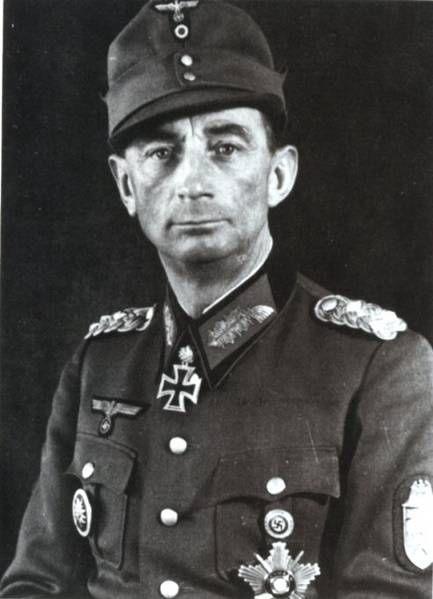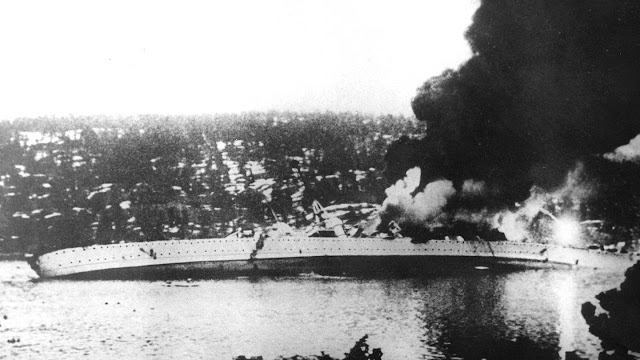Wednesday 10 April 1940
 |
| Narvik after the battle of 10 April 1940. |
US President Franklin Roosevelt issues Executive Order 8389, freezing Danish and Norwegian assets in the US to keep them out of German hands.
Operation Weserubung Naval Operations: The British quickly respond to the German invasion of Narvik by sending five H-class destroyers of the 2nd Destroyer Flotilla to the Ofotfjord to face ten Kriegsmarine destroyers. In a wild melee that begins at dawn in heavy snow, commander Captain Warburton-Lee (KIA) takes his ships in against Kommodore Friedrich Bonte (KIA), and both sides lose two ships:
- British: HMS Hardy (flagship) and HMS Hunter (run aground, then capsized);
- Germans: Wilhelm Heidkamp and Anton Schmitt
Without a landing force, the British destroyers come under shore fire and must depart, leaving the Wehrmacht ground forces under Generalleutnant Eduard Dietl’s 138th Gebirgsjäger Regiment in control. However, Dietl is now short of supplies because the British sank his supply ship Rauenfels. The remaining German destroyers also are short of fuel.
Narvik is the most isolated spot in Norway that the Wehrmacht has occupied, so German forces there are dangling perilously on the end of a long string. It is the one area in the entire country where the Allied forces could be said to have a home-field advantage.
Warburton-Lee is awarded the Victoria Cross and Bronte is awarded the Knight's Cross of the Iron Cross, both posthumously.
Elsewhere, German pocket battleship Lutzow is badly damaged on the way back to Germany by a submarine attack.
Elsewhere, U-4 (Oberleutnant zur See Hans-Peter Hinsch) sinks HMS Thistle (Lt. Commander Wilfrid F. Haselfoot,) southwest of Stavanger at 02:13 after Thistle fires at U-4 and misses. All 53 men on board Thistle perish.
British submarine HMS Tarpon is depth charged and sunk by a German Q-ship Schiff 40/Schürbek 50 miles off the Danish coast all 53 crew lost).
HMS Sunfish torpedoes and sinks German freighter Antares.
HMS Triton torpedoes and sinks German freighter Friedenau, German freighter Wigbert, and Kriegsmarine vessel V-1507.
Operation Weserubung Air Operations: The British Fleet Air Arm sends 15 Blackburn Skua dive-bombers of British Fleet Air Arm 800 and 803 against the Kriegsmarine cruiser Königsberg at Bergen and sinks it in an attack that comes out of the rising sun. This marks the first major naval victory by dive-bombing. The Germans lose 18 killed and 23 wounded. The British only lose one Skua when it develops engine trouble. One of the pilots, Captain Partridge, notes: "Only opposition: 1 AA gun. Tracer bullets drift up towards us like lazy golden raindrops going the wrong way."
 |
| Edouard Dietl, in command of German ground troops at Narvik. |
At Midtskogen farm, situated approximately 5 km (3.1 mi) west of the town Elverum at the mouth of the Østerdalen valley in southern Norway, German forces of about 100 Fallschirmjäger traveling in a convoy are ambushed by a scratch Norwegian force of Norwegian Royal Guards and local rifle club volunteers. The Germans are searching for King Haakon. At about 01:30, they are stopped at a roadblock and a firefight erupts. While casualties are light, the military attaché Hauptmann Eberhard Spiller, leader of the expedition, is killed. The Germans turn around at about 03:00 and head back to Oslo. The battle, while only a skirmish, is important for Norwegian morale.
Elsewhere, the Wehrmacht is largely unopposed and expands its holdings wherever they have landed. The ground troops at Narvik, however, are extremely isolated and short of supplies.
Battle of the Atlantic: U-37 (Korvettenkapitän Werner Hartmann) torpedoes and sinks the 9,076-ton Swedish tanker Sveaborg in the Atlantic 45 miles northwest of the Faroe Islands at 02:15. There are 29 survivors, 5 perish.
U-37 then spots the 5,128-ton Norwegian freighter Tosca coming to assist the Sveaborg. He pumps another torpedo into it at 03:23. There are 32 survivors and 2 perish.
U-50 is sunk by a Royal Navy destroyer off the Shetland Islands.
US President Franklin extends the combat zone under the Neutrality Act of 1939 to include the northwestern Soviet Union to take into account the German invasion of Norway.
Convoy OA 127 departs from Southend, Convoy OB 127 departs from Liverpool, Convoy HG 26F departs from Gibraltar, and Convoy HX 34 departs from Halifax.
European Air Operations: German aircraft raid Scapa flow and lose four of their number, three to anti-aircraft fire and one to a fighter.
French Government: The French sign contracts for the purchase of 2400 fighters and 2160 bombers, with first deliveries to be in September 1940.
Iceland: The Icelandic Parliament (Althing) severs its links with the mainland for the duration. While the Wehrmacht has occupied Denmark, the government remains intact, though of course subject to German domination.
Belgium: The Belgian government rejects another request by the Allies to allow troops on their soil.
 |
| Skua divebomber of 800 NAS. |
April 1940
April 1, 1940: Weserubung is a GoApril 2, 1940: British Subs On Alert
April 3, 1940: Churchill Consolidates Power
April 4, 1940: Missed the Bus
April 5, 1940: Mig-1 First Flight
April 6, 1940: Troops Sailing to Norway
April 7, 1940: Fleets At Sea
April 8, 1940: HMS Glowworm and Admiral Hipper
April 9, 1940: Invasion of Norway
April 10, 1940: First Battle of Narvik
April 11, 1940: Britain Takes the Faroes
April 12, 1940: Germans Consolidate in Norway
April 13, 1940: 2d Battle of Narvik
April 14, 1940: Battle of Dombås
April 15, 1940: British in Norway
April 16, 1940: Germans Cut Norway in Half
April 17, 1940: Trondheim the Target
April 18, 1940: Norway Declares War
April 19, 1940: Dombås Battle Ends
April 20, 1940: Germans Advancing in Norway
April 21, 1940: First US Military Casualty
April 22, 1940: First British Military Contact with Germans
April 23, 1940: British Retreating in Norway
April 24, 1940: British Bombard Narvik
April 25, 1940: Norwegian Air Battles
April 26, 1940: Norwegian Gold
April 27, 1940: Allies to Evacuate Norway
April 28, 1940: Prepared Piano
April 29, 1940: British at Bodo
April 30, 1940: Clacton-on-Sea Heinkel
2020





